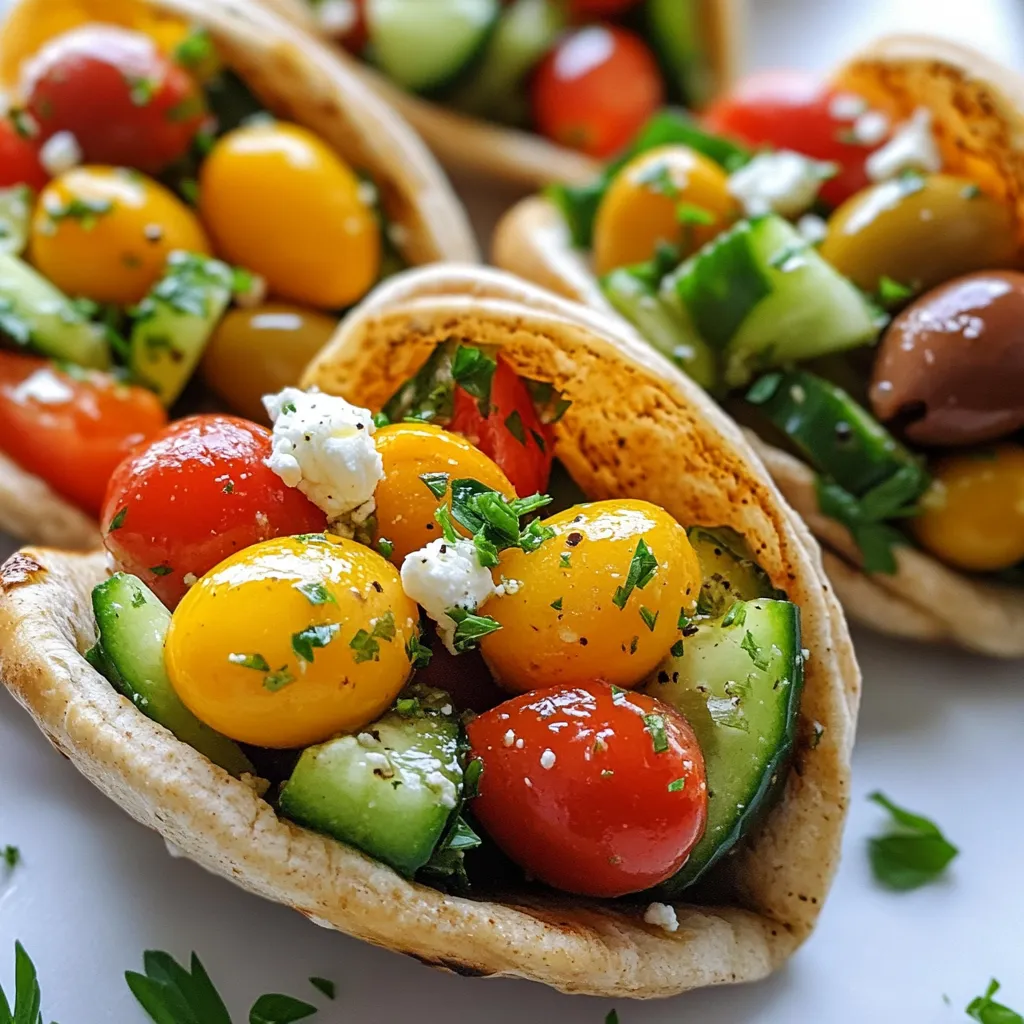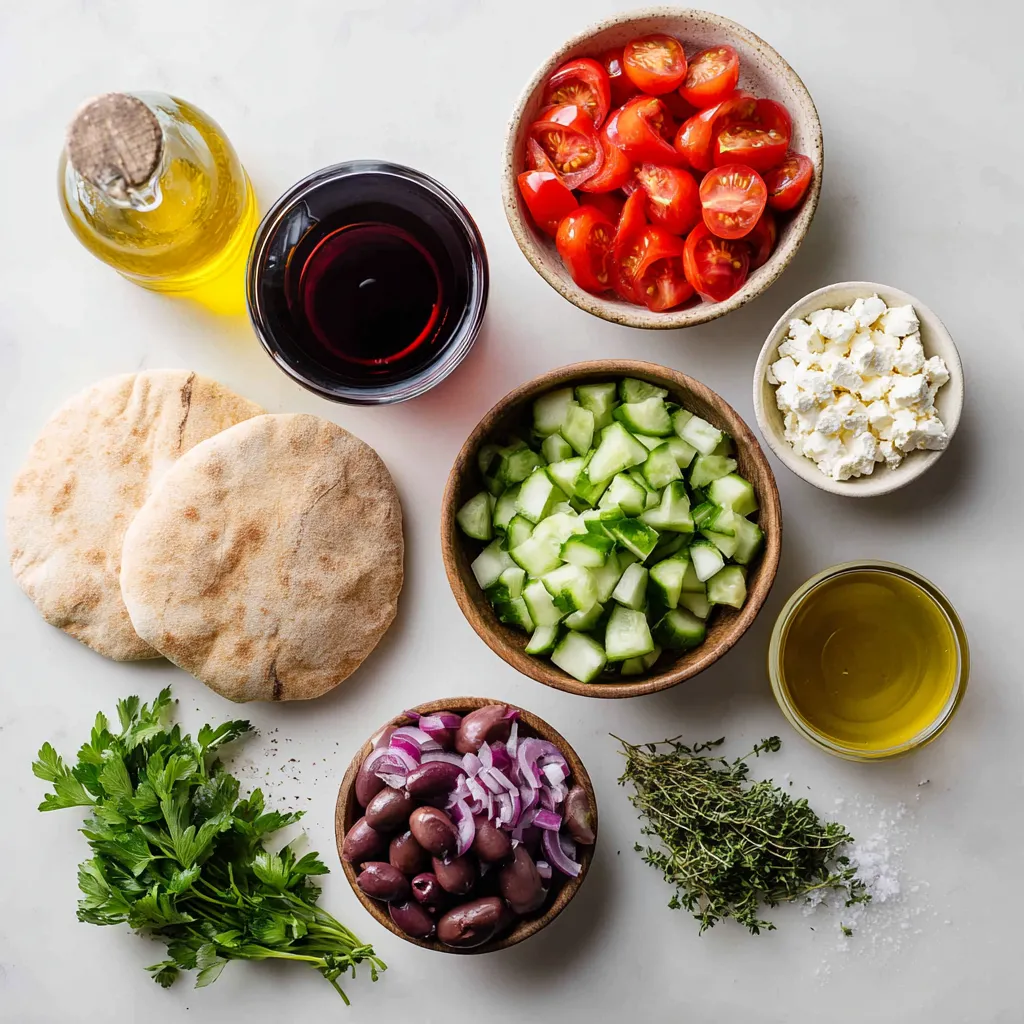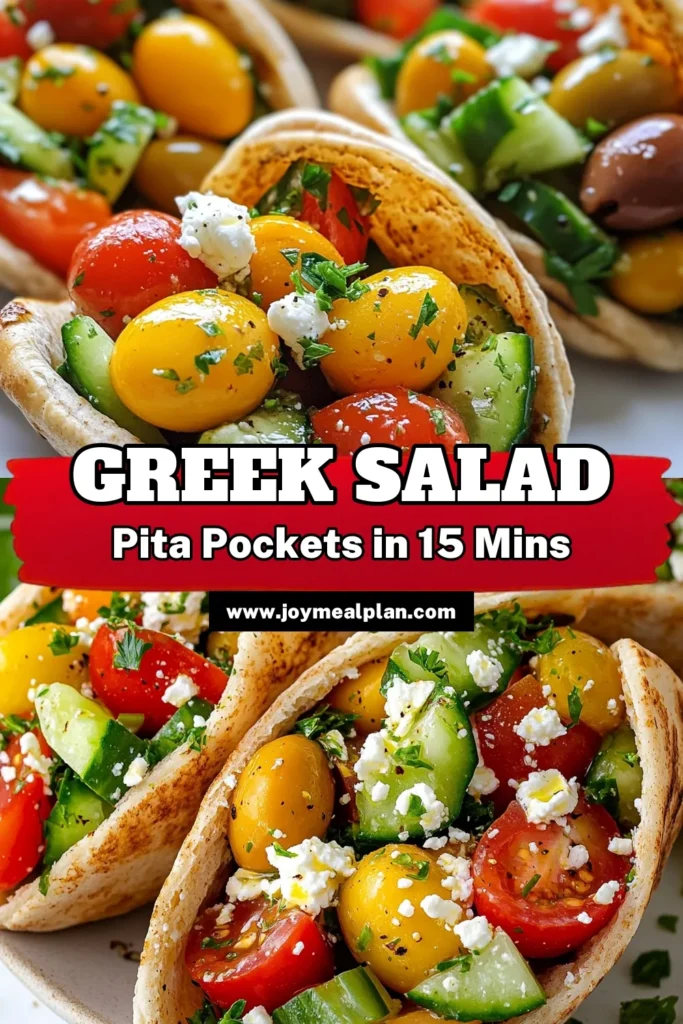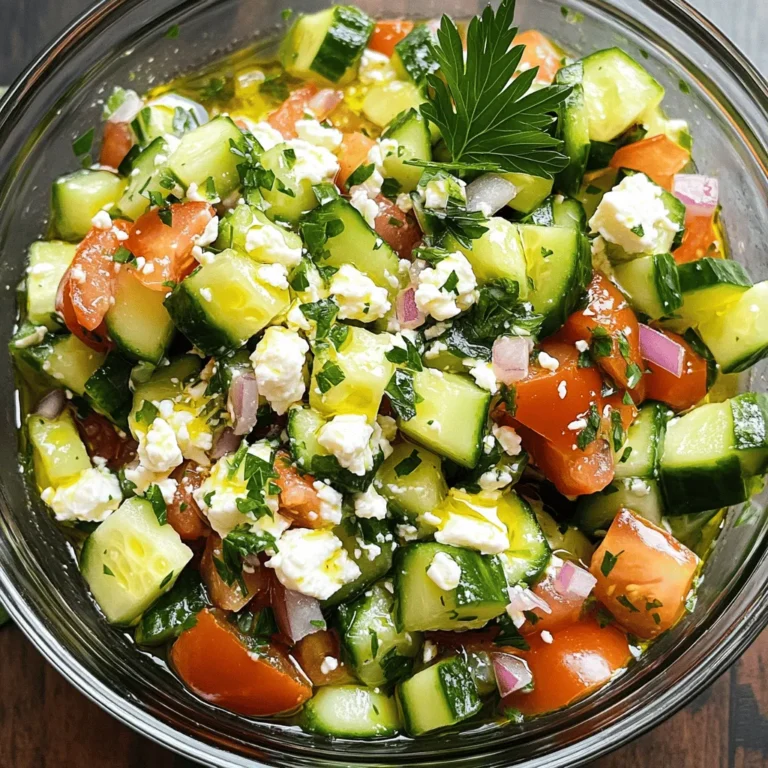Greek Salad Pita Pockets Fresh and Flavorful Delight

Are you ready to enjoy a fresh and flavorful lunch? Greek Salad Pita Pockets offer a tasty twist on a classic dish. They are packed with crunchy veggies and zesty dressing. In this guide, I’ll share the ingredients, steps, and tips to make these delicious pockets at home. Perfect for meal prep or a quick snack, you’ll want to savor every bite. Let’s dive in!
Why I Love This Recipe
- Fresh and Flavorful: This Greek Salad Pita Pocket is bursting with fresh vegetables and vibrant flavors, making it a delightful meal any time of the day.
- Quick to Prepare: In just 15 minutes, you can whip up these delicious pita pockets, perfect for a busy weeknight dinner or a healthy lunch on-the-go.
- Customizable: You can easily customize the ingredients based on your preferences or what you have on hand, making it a versatile recipe.
- Healthy and Nutritious: Packed with veggies and healthy fats from olives and olive oil, this recipe is not only tasty but also good for you.
Ingredients
Complete List of Ingredients for Greek Salad Pita Pockets
To make Greek salad pita pockets, gather these fresh ingredients:
– 4 whole wheat pita pockets
– 1 cup cherry tomatoes, halved
– 1 cucumber, diced
– 1 red bell pepper, diced
– 1/2 red onion, finely chopped
– 1 cup Kalamata olives, pitted and halved
– 1/2 cup feta cheese, crumbled
– 2 tablespoons fresh oregano, chopped
– 2 tablespoons extra-virgin olive oil
– 1 tablespoon red wine vinegar
– Salt and pepper to taste
– Optional: A handful of fresh parsley for garnish
Nutritional Information Overview
Greek salad pita pockets are not just tasty; they are healthy too. They offer a good mix of nutrients. Each serving has protein from feta cheese, healthy fats from olive oil, and fiber from whole wheat pita and veggies. This meal is low in calories while being rich in vitamins and minerals. Enjoying these pockets can help you feel full and satisfied.
Substitutions for Common Ingredients
You can easily swap some ingredients to fit your taste or needs:
– Pita pockets: Use gluten-free pita for a gluten-free option.
– Feta cheese: Try goat cheese or a dairy-free cheese if you prefer.
– Kalamata olives: Use green olives or skip them if you don’t like olives.
– Olive oil: Avocado oil works well too.
– Fresh oregano: Dried oregano can work in a pinch. Just use less since it’s stronger.
Feel free to mix and match to create your perfect Greek salad pita pocket!

Step-by-Step Instructions
Preparation of Vegetables
Start by washing all your fresh vegetables. I recommend using cherry tomatoes, cucumbers, red bell peppers, and red onions.
– Halve the cherry tomatoes.
– Dice the cucumber and red bell pepper.
– Finely chop the red onion.
Place all these veggies into a large mixing bowl. Gently toss them together. Be careful not to bruise the tomatoes. This step sets the base for our fresh salad.
Mixing the Salad Ingredients
Next, we add some tasty extras to our vegetable mix. Stir in the Kalamata olives and crumbled feta cheese.
– Use a gentle hand to mix.
You want to keep the feta cheese intact. This gives the salad a nice texture. It also adds a salty kick that pairs well with the olives.
Dressing the Salad and Stuffing the Pita
Now, let’s make the dressing. In a small bowl, whisk together:
– 2 tablespoons extra-virgin olive oil
– 1 tablespoon red wine vinegar
– 2 tablespoons fresh oregano, chopped
– A pinch of salt and pepper
Once mixed, pour this dressing over the salad. Toss gently to coat everything evenly.
Next, take a whole wheat pita pocket. Open it carefully by running a knife along the edge or gently pulling it apart. Fill each pocket with the salad mixture. Make sure to include plenty of olives and feta for the best flavor.
Repeat until all your pita pockets are stuffed. Enjoy this fresh and flavorful dish!
Tips & Tricks
How to Choose Fresh Ingredients
When making Greek salad pita pockets, fresh ingredients are key. Look for bright, firm cherry tomatoes. They should feel heavy for their size. Choose cucumbers that are crisp and have smooth skin. For bell peppers, opt for ones that are shiny with no soft spots. Red onions should be solid and firm. Kalamata olives should be pitted and dark purple. For feta cheese, find a block or crumbles with a creamy texture. Fresh oregano is best if you can find it, with bright green leaves.
Best Practices for Stuffing Pita Pockets
Stuffing pita pockets can be tricky. First, gently open each pocket without tearing it. Use a small knife or your fingers to create a pocket. Start by adding a layer of salad mixture at the bottom. This keeps the filling from spilling out. Next, fill it with olives and feta for extra flavor. Don’t overstuff, or it might burst. Aim for balance, so every bite is tasty.
Suggestions for Serving and Presentation
Presentation makes a meal special. Arrange the stuffed pita pockets on a large platter. You can fan them out for a nice look. Add a bowl of tzatziki sauce next to the platter for dipping. Sprinkle fresh parsley on top for color. If you like, serve extra Kalamata olives on the side. This adds a fun touch and gives everyone options. Enjoy your vibrant Greek feast!
Pro Tips
- Use Fresh Ingredients: Always opt for the freshest vegetables and herbs to enhance the flavor and nutritional value of your Greek Salad Pita Pockets.
- Chill Before Serving: For the best flavor, let the salad mixture chill in the refrigerator for at least 30 minutes before stuffing the pita pockets. This allows the flavors to meld beautifully.
- Customize Your Fillings: Feel free to add additional ingredients like avocado, artichokes, or grilled chicken to personalize your pita pockets according to your taste preferences.
- Perfect Pita Technique: When opening the pita pockets, gently run your fingers around the edge to avoid tearing. This keeps the pockets intact for filling.

Variations
Vegetarian and Vegan Options
Greek salad pita pockets are great for everyone. If you want a vegetarian option, just skip the feta cheese. For a vegan version, use a plant-based feta. This keeps the flavor without any dairy. Also, you can add more veggies, like zucchini or avocado. These choices add taste and nutrients.
Additional Ingredients to Include
Feel free to mix in other ingredients! Here are some ideas:
– Chopped artichokes for a tangy flavor
– Roasted red peppers for sweetness
– Spinach or kale for extra greens
– Chickpeas for added protein and texture
These additions make your pita pockets even more delicious. You can create your own unique version!
Different Dressing Ideas
The dressing makes the meal shine. While the olive oil and vinegar are classic, you can try different flavors. Here are some options:
– Lemon juice for a fresh kick
– Balsamic vinegar for a sweet touch
– Greek yogurt for creaminess
– Tahini for a nutty flavor
Experiment with these dressings to find your favorite! Each one adds a new twist to the Greek salad pita pockets.
Storage Info
How to Store Leftover Pita Pockets
To keep your Greek salad pita pockets fresh, store them in the fridge. Place them in a sealed container to prevent them from drying out. If you have extra salad, store it separately. This way, the pita won’t get soggy.
Recommended Storage Containers
Use airtight containers or resealable bags for storage. Glass containers work well and are eco-friendly. If you prefer plastic, choose BPA-free options. Label the containers with the date, so you know when to eat them.
Reheating Tips and Best Practices
Reheat your pita pockets gently. Use a microwave for a quick warm-up. Heat for about 15-20 seconds at a time. Check often to avoid overheating. If you want a crispy texture, use an oven. Preheat it to 350°F (175°C), wrap the pockets in foil, and heat for about 10 minutes. Enjoy them warm for the best taste!
FAQs
What sides go well with Greek Salad Pita Pockets?
You can pair your Greek salad pita pockets with various sides. Some great options include:
– Tzatziki sauce for dipping
– Roasted vegetables for a warm side
– Hummus with pita chips
– A light fruit salad for sweetness
These sides will enhance your meal and offer different textures. They also add more flavors that complement the refreshing taste of the salad.
Can I prepare the salad ahead of time?
Yes, you can prepare the salad ahead of time. Just follow these steps:
1. Chop the vegetables: You can cut the tomatoes, cucumber, bell pepper, and onion in advance.
2. Mix the salad: Combine everything except the dressing. This keeps veggies fresh.
3. Store in the fridge: Keep it in an airtight container for up to 24 hours.
When ready to eat, add the dressing and stuff the pita pockets. This method saves time and keeps the salad crisp.
How do I make these pita pockets gluten-free?
Making gluten-free Greek salad pita pockets is simple. Here’s how:
– Use gluten-free pita bread: Many stores sell gluten-free options. Check the label.
– Ensure all ingredients are gluten-free: Confirm that olives, feta, and any added spices are gluten-free.
Follow the same steps in the recipe. You’ll get a tasty meal that everyone can enjoy!
Greek salad pita pockets are easy to make and packed with flavor. We covered the ingredients, steps to prepare, and useful tips for a great meal. You learned how to store leftovers and variations to try. Remember, fresh ingredients make a big difference. Experiment with different dressings and fillings to keep it exciting. With these ideas, you’re ready to create delicious and healthy pita pockets. Enjoy your cooking journe

Greek Salad Pita Pockets
Ingredients
- 4 whole wheat pita pockets
- 1 cup cherry tomatoes, halved
- 1 whole cucumber, diced
- 1 whole red bell pepper, diced
- 0.5 whole red onion, finely chopped
- 1 cup Kalamata olives, pitted and halved
- 0.5 cup feta cheese, crumbled
- 2 tablespoons fresh oregano, chopped
- 2 tablespoons extra-virgin olive oil
- 1 tablespoon red wine vinegar
- 1 pinch salt and pepper to taste
- 1 handful fresh parsley for garnish (optional)
Instructions
- Begin by washing and preparing your vegetables. In a large mixing bowl, combine the halved cherry tomatoes, diced cucumber, diced red bell pepper, and finely chopped red onion. Toss gently to mix without bruising the tomatoes.
- Next, stir in the Kalamata olives and crumbled feta cheese into the vegetable mixture. Use a gentle hand to mix everything together, ensuring the feta remains intact for texture.
- In a separate small bowl, create the dressing by whisking together the extra-virgin olive oil, red wine vinegar, chopped oregano, and a generous pinch of salt and pepper. Once well combined, pour this dressing over the salad mixture. Toss gently again to ensure every ingredient is evenly coated with the delicious dressing.
- Take one whole wheat pita pocket and carefully open it up by running a knife along the edge or just pulling it apart gently. Fill each pocket generously with the Greek salad mixture, ensuring each one receives a good mix of olives and feta for a flavorful bite.
- Repeat the stuffing process until all pita pockets are filled with the vibrant salad mixture.
- If you like, finish your creations with a sprinkle of fresh parsley on top of each stuffed pita pocket for a burst of color and freshness before serving.


. To store unused tomato mixture, place it in an airtight container. This keeps the mix fresh for up to two days. If you have leftover bruschetta, avoid adding toppings until you're ready to serve. This prevents the bread from getting soggy. For the bread, store it in a paper bag. This helps maintain its crispness. Avoid plastic bags, as they trap moisture and make the bread soft. If you want to keep the bread fresh longer, freeze it. Just slice the bread before freezing for easy use later. You can freeze the tomato mixture and the bread separately. This helps keep each part fresh. To freeze the tomato mix, pour it into a freezer-safe bag. Remove excess air before sealing. When you're ready to eat, thaw the mixture overnight in the fridge. For the bread, place it in the oven at 350°F (175°C) for about 10 minutes to restore its crunch. Enjoy your bruschetta within three days for the best taste. Over time, the tomatoes may lose their fresh flavor. Look for signs of spoilage like discoloration or an off smell. If the bread feels soft or stale, it’s time to toss it. By following these simple storage tips, you can extend the life of your delicious bruschetta. Enjoy it fresh and vibrant every time! The best breads for bruschetta are Italian baguette or ciabatta. Both have a nice crust that crisps up well. You can also use sourdough for a tangy flavor. Choose a bread that is sturdy enough to hold the toppings. Yes! You can prepare the tomato mix a few hours ahead. Just store it in the fridge. This lets the flavors blend. Toast the bread right before serving for the best crunch. Keep the bread and topping separate until you serve. To serve more people, double the recipe. Use multiple loaves of bread. You can also make several batches of the tomato mix. It’s easy to scale up. Just remember to toast the bread in batches to keep it crisp. Bruschetta is best served fresh. The toasted bread should be warm. The tomato mix can be at room temperature. This combo gives a nice contrast. Serve it right after you assemble it for the best taste. Bruschetta pairs well with simple sides. Think of a light salad or soup. A fresh arugula salad works great. You can also serve it with olives or cheese. These add nice flavors and textures to your meal. In this post, we explored making bruschetta from fresh ingredients like ripe tomatoes, basil, and garlic. You learned how to prepare these components and create the perfect toast. We also covered tips for storage and common mistakes to avoid. Finally, I shared variations for different seasons and diets. Bruschetta is simple, fun, and a delightful treat. Enjoy experimenting and finding your favorite flavors!](https://joymealplan.com/wp-content/uploads/2025/07/10355497-7bd2-4922-b413-5484ea4e8a3f-768x768.webp)




